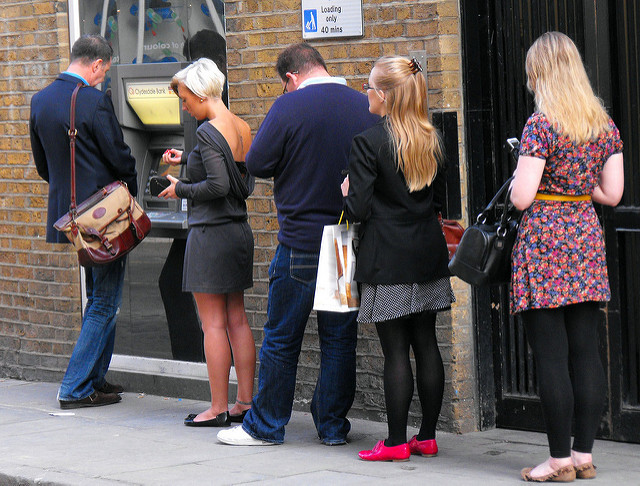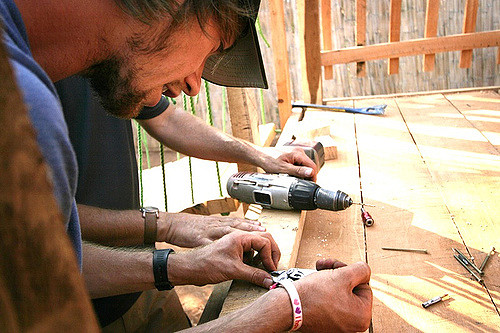Search Results: one of the few
A Tale Of Two Managers
filed in Marketing, Storytelling, Strategy
 My local bank manager, at the branch five minutes walk from my home, works hard to help customers navigate the bank’s new automated systems and services. He’s on hand to show everyone depositing cash how to bypass a teller and make a deposit using the machine in the foyer.
My local bank manager, at the branch five minutes walk from my home, works hard to help customers navigate the bank’s new automated systems and services. He’s on hand to show everyone depositing cash how to bypass a teller and make a deposit using the machine in the foyer.
The bank manager at the branch where I choose to bank (three suburbs and a thirty-minute tram ride away), works hard to get to know his customers. He chooses to man the customer service desk so that he can hear his customer’s stories. He knows his customers by name and prioritises understanding their goals before serving them. He prides himself on making sure they are paying less interest and incurring fewer fees.
Both managers care, but there’s a subtle distinction in how they choose to serve. The second bank manager wins because he cares less about finding customers for his products and more about finding the right products for his customers. And he goes home knowing that he’s done work he’s proud to have done.
Image by Spixey
Pedestals
 Whoever said you should never meet your heroes was only partly right. There is an element of truth in the adage. Reality can rarely compete with the imaginary. Fleeting, real encounters are flat—two dimensional at best. The imagined meeting is all deep connection and unspoken understanding on both sides. In matters of hero worship, the admirer has the unfair advantage over the admired. The poor hero has little sense of the depth of feeling and gratitude upon which his pedestal is built.
Whoever said you should never meet your heroes was only partly right. There is an element of truth in the adage. Reality can rarely compete with the imaginary. Fleeting, real encounters are flat—two dimensional at best. The imagined meeting is all deep connection and unspoken understanding on both sides. In matters of hero worship, the admirer has the unfair advantage over the admired. The poor hero has little sense of the depth of feeling and gratitude upon which his pedestal is built.
The problem isn’t that we shouldn’t have heroes or build pedestals, it’s that we erect our pedestals too infrequently and for too few. What makes the girl putting in an eight-hour day shampooing hair at the salon, carefully placing fresh towels under strained necks, less or a hero than the rock star who can dazzle the crowd for an hour? Why do we value the contribution from the stage above the one from the heart?
We believe in superstars whose job it is to live up to the image we’ve created. What if instead of looking to the false gods of our imagination for inspiration, we applauded the real acts of ordinary heroism we choose to ignore? When we change our attitude to greatness we change the way we move through the world.
Image by Martin Fisch
Choose Delight Over Satisfaction
 When a flight is delayed why are the passengers who quietly accept their fate and meal vouchers never the ones who get priority on the next available flight? Our instinct is to acknowledge and take care of the customer who complains the loudest. We work hardest to get the dissatisfied, those unlikely to become raving fans, to the point of satisfaction. This strategy leaves fewer resources to delight our satisfied customers. It’s easy to take the contented regular for granted.
When a flight is delayed why are the passengers who quietly accept their fate and meal vouchers never the ones who get priority on the next available flight? Our instinct is to acknowledge and take care of the customer who complains the loudest. We work hardest to get the dissatisfied, those unlikely to become raving fans, to the point of satisfaction. This strategy leaves fewer resources to delight our satisfied customers. It’s easy to take the contented regular for granted.
It’s hard to ignore the noisy bell. But focusing on the people who don’t feel they have a voice is the most important work we can do. Who are you taking for granted and how can you make them happier?
Image by Scott Ableman
Don’t Be Afraid To Start Small
 On a rainy Monday early in December 1955, 40,000 African-Americans boycotted the public bus services in the town of Montgomery to protest the arrest of 42-year-old Rosa Parks who refused to give up her seat to a white passenger. Their boycott lasted 381 days until the city repealed its law requiring segregation on public buses. Rosa Parks’ story is one of the most enduring examples we have of the power of one person to change everything.
On a rainy Monday early in December 1955, 40,000 African-Americans boycotted the public bus services in the town of Montgomery to protest the arrest of 42-year-old Rosa Parks who refused to give up her seat to a white passenger. Their boycott lasted 381 days until the city repealed its law requiring segregation on public buses. Rosa Parks’ story is one of the most enduring examples we have of the power of one person to change everything.
We tend to forget that the ‘power of one’ rule also applies to revolutions in the commercial world. Philip Mills choreographed his first barbell workout in the remote city of Auckland, New Zealand in 1990. Today he is the CEO of Les Mills International—the hugely successful global fitness brand, with over 130,000 certified instructors delivering classes to more than 6 million people every week in more than 100 countries around the world. To put that into perspective, the population of New Zealand today stands at 4.5 million.
It’s natural to want to get your product into the hands of everyone who needs it. But thinking about how to influence the masses leads to missteps in understanding what’s driving the decisions of the few people you have the best chance of reaching and impacting right now. Like any revolution, success happens one user, one customer, one raving fan at a time. Never be afraid to start small.
Image by Jasperdo.
The Two Questions Behind Every Successful Product And Service
filed in Innovation, Marketing, Strategy
 There’s a subtle difference between a product or service that stems from an idea and one that’s born from recognising an opportunity. Ideas are solutions in search of problems. Opportunities are problems begging for a solution. The magic of solving problems for a specific customer is that the marketing is baked into the product.
There’s a subtle difference between a product or service that stems from an idea and one that’s born from recognising an opportunity. Ideas are solutions in search of problems. Opportunities are problems begging for a solution. The magic of solving problems for a specific customer is that the marketing is baked into the product.
Like many disruptive companies, the team at Dollar Shave Club created a compelling product, innovative business model and viral marketing campaign simply by understanding their customer’s pain points.
We find opportunities when we look for problems to solve, by asking the following two questions:
1. What’s happening that shouldn’t be?
2. What’s not happening, that should be?
In the case of Dollar Shave Club, the answers were clear. The razor blade market was dominated by a few legacy brands who had no direct relationship with their customers. Men were paying a lot of money for shave tech they didn’t need. Buying expensive razor blades didn’t necessarily guarantee a better shaving experience. Shopping for razors and replacing blades wasn’t as convenient as it could be. The startup disrupted the market by addressing these unmet needs.
The utility, quality and success of our products and services improve when we pay attention to what’s missing in our customers’ lives.
What gaps can you fill for your customers?
[Learn more about turning your insights into successful products and services in my new book, Hunch].
Image by Thomas Hawk.
Where Will Your Next Big Idea Come From?
filed in Innovation, Strategy
 A few weeks before Hillary Clinton was defeated in the US presidental election I met a guy selling hats emblazoned with both candidates’ names outside the Rockerfeller Center in New York.
A few weeks before Hillary Clinton was defeated in the US presidental election I met a guy selling hats emblazoned with both candidates’ names outside the Rockerfeller Center in New York.
‘There will be a big upset in this election. Trump hats are selling like hotcakes,’ he said. It was hard to believe. Just the day before at a behavioural economics conference in Manhattan the academics and experts who had crunched every data point predicted exactly the opposite. The data showed Hillary was on track. But the sales in Trump hats didn’t lie. The data worth paying attention to was closer to home. It was in the stories of the people on the streets of towns where those who wrote the algorithms didn’t live and work.
In our digitally, data-stamped world, facts are king and intuition gets a bad rap. Author Michael Lewis describes the ‘powerful trend to mistrust human intuition and defer to algorithms’ that came about as a result of the work of scientists in the field of behavioural economics. The irony, of course, is that scientists too start out with nothing more than a hunch about what’s worth investigating further. Even those whose job it is to demonstrate proof start out not knowing for sure.
Things are no different when it comes to innovating in the commercial world. Where was the data that predicted the need for and subsequent success of Google, Facebook and the iPhone, or the decline of Kodak, BlackBerry and orange juice? Which analyst forecast the 250 per cent increase in almond milk sales in the US over the past five years? Who anticipated that yoga pants would unseat jeans in popular culture, to spawn an active-wear revolution that will help the sports-apparel market be worth a predicted $178 billion globally by 2019? And what about colouring books for adults, with an estimated 12 million sold in 2015 in the US alone – who saw that juggernaut coming? When it comes to making predictions about which ideas will fly, we tend to forget that we can only use the information we have at hand about the past or the present to make a judgement call or prediction about the future. We don’t (or can’t) know the significance of things we have no information about, or haven’t yet thought to measure, and can’t possibly know for sure. Data may be able to tell us what people do and how they do it, but critically, not why they do it.
Intuition, on the other hand, enables us to tap into our shared human experience to reveal a fundamental truth about what it is people want and need. Often there is no reliable data to go on—which is why the disposable nappy was invented by a frustrated mother, and Warby Parker was the brainchild of a guy who’d gone without glasses for a college semester because he couldn’t afford to replace the ones he’d lost. These stories of curious, empathetic and imaginative people who built successful businesses by seeing problems that were begging for a solution are retold over and over again. Successful entrepreneurs don’t wait for proof that their idea will work. They learn to trust their gut and go.
My new book Hunch: Turn Your Everyday Insights Into The Next Big Thing goes on sale in the UK and Australia today. If you’re in the US, you’ve got just a few more days to wait. Hunch will help you to harness the power of your intuition so you can recognise opportunities others miss and create the breakthrough idea the world is waiting for. Filled with success stories, reflection exercises and writing prompts, I hope it will be your guide to embracing your unique potential and discovering winning ideas.
The Power Of Expectations
filed in Marketing, Storytelling
 The packaging on the flat-pack garden shed promised fast, easy assembly (80% faster than the competitor’s product), using 75% fewer screws, pre-drilled holes and a 30-year warranty. Taking the manufacturer at their word the customer’s expectation is set. The shed takes two people five hours to assemble, requires additional drilling, a trip to the hardware store to buy a special riveting tool and leaves the weary handymen with a bag of fifty extra screws and abandoned Sunday afternoon plans. There’s a clear mismatch between the expectation the company set and the reality the customer experienced.
The packaging on the flat-pack garden shed promised fast, easy assembly (80% faster than the competitor’s product), using 75% fewer screws, pre-drilled holes and a 30-year warranty. Taking the manufacturer at their word the customer’s expectation is set. The shed takes two people five hours to assemble, requires additional drilling, a trip to the hardware store to buy a special riveting tool and leaves the weary handymen with a bag of fifty extra screws and abandoned Sunday afternoon plans. There’s a clear mismatch between the expectation the company set and the reality the customer experienced.
Dissatisfied customers are not just created by products and services that don’t work. Dissatisfaction is also a direct result of the stories we the marketers lead customers to believe. Expectations once set are hard to shift. Our words have the power to change so much more than the customer’s decision to click the buy button. We should use them wisely.
Image by Melody Hansen.
Less But Better
 In the bygone era of local shopping strips lined with family owned businesses the job of each business wasn’t simply to make a profit—it was to add value to the community it served. Every business had a purpose beyond the single bottom line. Every transaction, from a pint of milk to five screws wrapped tightly in brown paper, mattered. Paradoxically it was the care the owners took with the smallest order that helped them to thrive for longer than the big chain stores might have predicted.
In the bygone era of local shopping strips lined with family owned businesses the job of each business wasn’t simply to make a profit—it was to add value to the community it served. Every business had a purpose beyond the single bottom line. Every transaction, from a pint of milk to five screws wrapped tightly in brown paper, mattered. Paradoxically it was the care the owners took with the smallest order that helped them to thrive for longer than the big chain stores might have predicted.
We’ve come to believe that people always want more or that they invariably choose the fast and easy option. This isn’t true of every customer. What if instead of trying to deliver more, faster to everyone we strived to do less but better for fewer?
Image by John Weiss.
Why You Need An If-Then Storytelling Strategy
filed in Storytelling, Strategy
 It was a slow Thursday evening at the iconic sportswear store. There were more sales assistants than customers silently wandering through the displays across polished black tiles. Alan decided to approach a customer who had just picked up a premium shoe, turning it over to check out the price.
It was a slow Thursday evening at the iconic sportswear store. There were more sales assistants than customers silently wandering through the displays across polished black tiles. Alan decided to approach a customer who had just picked up a premium shoe, turning it over to check out the price.
‘Can I help you?’ he said.
‘No, I’m just looking, thanks.’ she replied.
‘It would be good to get out of those Nikes. Have your tried our SuperBOOST shoes?’ said Alan.
‘No.’ said the customer, as she hastily put the shoe back.
‘They’re really comfortable and last longer.’ Alan said to the customer as she started to walk away.
We would never say half of the things we say or ask many of the questions we ask if we stopped for a second to think how the customer was likely to respond. What if instead of following a script that leads us to a dead end, we anticipated where our questions would lead the customer? We know that 99% of the time the response to, ‘Can I help you?’, will be, ‘No.’ So how can we do better?
An if-then storytelling strategy invites us to be more empathetic towards the customer and more discerning with our questions.
If the customer is browsing for more than a few minutes, then I will ask how I can help.
If the customer is looking at running shoes, then I will ask her what kind of training she does.
If the customer picks up an item, then I will ask her if she’d like to try her size.
If the customer asks for her size, then I will try getting to know more about what she needs from her shoes.
Better brand stories, marketing and sales conversations always start with understanding what unmet need or unspoken desire brought the customer to us, rather than with our need to say something when it’s convenient.
Image by Amira A.
The Right Words
filed in Marketing, Storytelling
 When we have a message to communicate, we obsess over finding the right words. Which copy will convert better? How can we construct the perfect offer that draws people in?
When we have a message to communicate, we obsess over finding the right words. Which copy will convert better? How can we construct the perfect offer that draws people in?
What we lose in our attempt to optimise the words is the ability to create a deeper more lasting connection with the reader, user or customer. We forget that we’re not just in the business of trying to win a sale today, but that we’re aiming to build a relationship that sustains both the people we hope to serve and ourselves.
Yesterday a note arrived in the letterbox from our wonderful local council. They’re resurfacing the road and repairing the pavement on our street next week, and of course, there will be disruptions. The note addressed to owner/occupier, goes straight into the project details, time frame, parking and access. It ends with a warning that vehicles parked will be towed and an apology for any inconvenience caused. What a missed opportunity not simply to inform, but to deepen connections with people in the community.
The whole tone of the message could be flipped on its head by positioning as something to celebrate.
‘We’re delighted to let you know we’re starting work on improving your street next week. No more potholes! Obviously, this will mean some disruption and inconvenience for a few days, but we hope you’ll think it’s worth it when you cycle down the brand spanking new road. Here’s what you need to know and how you can help.’
What we say might get people’s attention, but how we say it changes not only what they think, but how they feel and act. It’s worth considering how you want people to feel after they’ve read or heard your message, not just about what you want them to do next.
Image by Hans Splinter.